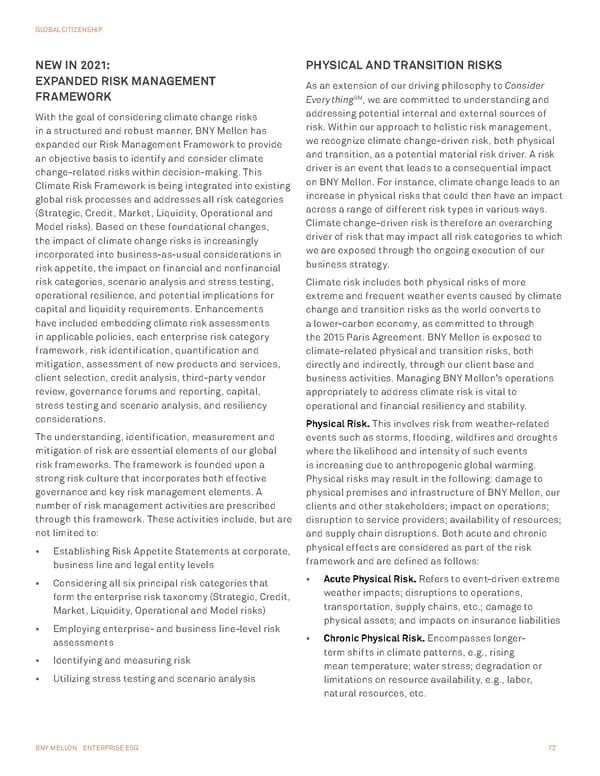BNY MELLON ENTERPRISE ESG 72 GLOBAL CITIZENSHIP NEW IN 2021: EXPANDED RISK MANAGEMENT FRAMEWORK With the goal of considering climate change risks in a structured and robust manner, BNY Mellon has expanded our Risk Management Framework to provide an objective basis to identify and consider climate change-related risks within decision-making. This Climate Risk Framework is being integrated into existing global risk processes and addresses all risk categories (Strategic, Credit, Market, Liquidity, Operational and Model risks). Based on these foundational changes, the impact of climate change risks is increasingly incorporated into business-as-usual considerations in risk appetite, the impact on financial and nonfinancial risk categories, scenario analysis and stress testing, operational resilience, and potential implications for capital and liquidity requirements. Enhancements have included embedding climate risk assessments in applicable policies, each enterprise risk category framework, risk identification, quantification and mitigation, assessment of new products and services, client selection, credit analysis, third-party vendor review, governance forums and reporting, capital, stress testing and scenario analysis, and resiliency considerations. The understanding, identification, measurement and mitigation of risk are essential elements of our global risk frameworks. The framework is founded upon a strong risk culture that incorporates both effective governance and key risk management elements. A number of risk management activities are prescribed through this framework. These activities include, but are not limited to: • Establishing Risk Appetite Statements at corporate, business line and legal entity levels • Considering all six principal risk categories that form the enterprise risk taxonomy (Strategic, Credit, Market, Liquidity, Operational and Model risks) • Employing enterprise- and business line-level risk assessments • Identifying and measuring risk • Utilizing stress testing and scenario analysis PHYSICAL AND TRANSITION RISKS As an extension of our driving philosophy to Consider Everything SM , we are committed to understanding and addressing potential internal and external sources of risk. Within our approach to holistic risk management, we recognize climate change-driven risk, both physical and transition, as a potential material risk driver. A risk driver is an event that leads to a consequential impact on BNY Mellon. For instance, climate change leads to an increase in physical risks that could then have an impact across a range of different risk types in various ways. Climate change-driven risk is therefore an overarching driver of risk that may impact all risk categories to which we are exposed through the ongoing execution of our business strategy. Climate risk includes both physical risks of more extreme and frequent weather events caused by climate change and transition risks as the world converts to a lower-carbon economy, as committed to through the 2015 Paris Agreement. BNY Mellon is exposed to climate-related physical and transition risks, both directly and indirectly, through our client base and business activities. Managing BNY Mellon’s operations appropriately to address climate risk is vital to operational and financial resiliency and stability. Physical Risk. This involves risk from weather-related events such as storms, flooding, wildfires and droughts where the likelihood and intensity of such events is increasing due to anthropogenic global warming. Physical risks may result in the following: damage to physical premises and infrastructure of BNY Mellon, our clients and other stakeholders; impact on operations; disruption to service providers; availability of resources; and supply chain disruptions. Both acute and chronic physical effects are considered as part of the risk framework and are defined as follows: • Acute Physical Risk. Refers to event-driven extreme weather impacts; disruptions to operations, transportation, supply chains, etc.; damage to physical assets; and impacts on insurance liabilities • Chronic Physical Risk. Encompasses longer- term shifts in climate patterns, e.g., rising mean temperature; water stress; degradation or limitations on resource availability, e.g., labor, natural resources, etc.
 BNY Mellon ESG Report Page 71 Page 73
BNY Mellon ESG Report Page 71 Page 73